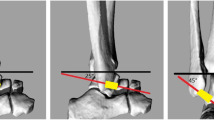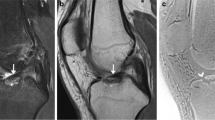Abstract
Objective
To compare the diagnostic performance and inter-reader agreement of an abbreviated (5 min) MR protocol compared to a complete (25 min) protocol, for evaluation of suspected tibial bone stress injury.
Materials and methods
This IRB-approved retrospective study consisted of 95 consecutive MR examinations in 88 patients with suspected tibial bone stress injury. Three musculoskeletal radiologists independently classified all examinations utilizing both an abbreviated protocol consisting only of axial T2-weighted images with fat suppression, and after a washout period again classified the complete examinations. Accuracy was calculated as proportion of cases classified exactly, within 1 grade, within 2 grades, and also utilizing a simplified “clinically relevant” classification combining grades 2, 3, and 4A into a single group. Significance testing was performed with the chi-test, and a post-hoc power analysis was performed. Inter-reader agreement was calculated with Kendall’s coefficient of concordance, with significance testing performed utilizing the z-test after bootstrapping to obtain the standard error.
Results and conclusions
There was no significant difference in accuracy of grading tibial bone stress injuries between complete and abbreviated examinations. For complete exams, pooled exact accuracy was 47.8%; accuracy within 1 grade was 82.8%; and accuracy within 2 grades was 96.1%. For the abbreviated protocol, corresponding accuracies were 50.2, 82.0, and 93.9%. With the “clinically relevant” simplified classification, accuracy was 58.6% for complete exams and 64.2% for abbreviated exams. There was no significant difference in inter-reader agreement, with substantial agreement demonstrated for both complete (Kendall coefficient of concordance 0.805) and abbreviated examinations (coefficient of 0.767).









Similar content being viewed by others
References
Mandell JC, Khurana B, Smith SE. Stress fractures of the foot and ankle, part 1: biomechanics of bone and principles of imaging and treatment. Skelet Radiol. 2017;46(8):1021–9.
Mandell JC, Khurana B, Smith SE. Stress fractures of the foot and ankle, part 2: site-specific etiology, imaging, and treatment, and differential diagnosis. Skeletal Radiol. 2017;46(9):1165–1186
Marshall RA, Mandell JC, Weaver MJ, Ferrone M, Sodickson A, Khurana B. Imaging features and management of stress, atypical, and pathologic fractures. Radiographics. 2018;38(7):2173–92.
Fredericson M, Jennings F, Beaulieu C, Matheson GO. Stress fractures in athletes. Top Magn Reson Imaging. 2006;17(5):309–25.
Iwamoto J, Takeda T. Stress fractures in athletes: review of 196 cases. J Orthop Sci. 2003;8(3):273–8.
Wilson ES, Katz FN. Stress fractures: an analysis of 250 consecutive cases. Radiology. 1969;92(3):481–6 passim.
Greaney RB, Gerber FH, Laughlin RL, Kmet JP, Metz CD, Kilcheski TS, et al. Distribution and natural history of stress fractures in U.S. marine recruits. Radiology. 1983;146(2):339–46.
Hadid A, Moran DS, Evans RK, Fuks Y, Schweitzer ME, Shabshin N. Tibial stress changes in new combat recruits for special forces: patterns and timing at MR imaging. Radiology. 2014;273(2):483–90.
Kijowski R, Choi J, Mukharjee R, de Smet A. Significance of radiographic abnormalities in patients with tibial stress injuries: correlation with magnetic resonance imaging. Skelet Radiol. 2007;36(7):633–40.
Wright AA, Hegedus EJ, Lenchik L, Kuhn KJ, Santiago L, Smoliga JM. Diagnostic accuracy of various imaging modalities for suspected lower extremity stress fractures: a systematic review with evidence-based recommendations for clinical practice. Am J Sports Med. 2016;44(1):255–63.
Fredericson M, Bergman AG, Hoffman KL, Dillingham MS. Tibial stress reaction in runners. Correlation of clinical symptoms and scintigraphy with a new magnetic resonance imaging grading system. Am J Sports Med. 1995;23(4):472–81.
Kijowski R, Choi J, Shinki K, Del Rio AM, De Smet A. Validation of MRI classification system for tibial stress injuries. Am J Roentgenol. 2012;198(4):878–84.
Wang B, Fintelmann FJ, Kamath RS, Kattapuram SV, Rosenthal DI. Limited magnetic resonance imaging of the lumbar spine has high sensitivity for detection of acute fractures, infection, and malignancy. Skelet Radiol. 2016;45(12):1687–93.
Khurana B, Okanobo H, Ossiani M, Ledbetter S, Al Dulaimy K, Sodickson A. Abbreviated MRI for patients presenting to the emergency department with hip pain. Am J Roentgenol. 2012;198(6):17–9.
Fritz J, Fritz B, Thawait GG, Meyer H, Gilson WD, Raithel E. Three-dimensional CAIPIRINHA SPACE TSE for 5-minute high-resolution MRI of the knee. Investig Radiol. 2016;51(10):609–17.
Altahawi FF, Blount KJ, Morley NP, Raithel E, Omar IM. Comparing an accelerated 3D fast spin-echo sequence (CS-SPACE) for knee 3-T magnetic resonance imaging with traditional 3D fast spin-echo (SPACE) and routine 2D sequences. Skelet Radiol. 2017;46(1):7–15.
Lee SH, Lee YH, Suh JS. Accelerating knee MR imaging: compressed sensing in isotropic three-dimensional fast spin-echo sequence. Magn Reson Imaging. 2018;46:90–7.
Lee SH, Lee YH, Song HT, Suh JS. Rapid acquisition of magnetic resonance imaging of the shoulder using three-dimensional fast spin echo sequence with compressed sensing. Magn Reson Imaging. 2017;42:152–7.
Subhas N, Benedick A, Obuchowski NA, Polster JM, Beltran LS, Schils J, et al. Comparison of a fast 5-minute shoulder MRI protocol with a standard shoulder MRI protocol: a multiinstitutional multireader study. Am J Roentgenol. 2017;208(4):W146–54.
Kalia V, Fritz B, Johnson R, Gilson WD, Raithel E, Fritz J. CAIPIRINHA accelerated SPACE enables 10-min isotropic 3D TSE MRI of the ankle for optimized visualization of curved and oblique ligaments and tendons. Eur Radiol. 2017;27(9):3652–61.
Sayah A, Jay AK, Toaff JS, Makariou EV, Berkowitz F. Effectiveness of a rapid lumbar spine MRI protocol using 3D T2-weighted space imaging versus a standard protocol for evaluation of degenerative changes of the lumbar spine. Am J Roentgenol. 2016;207(3):614–20.
Longo MG, Fagundes J, Huang S, Mehan W, Witzel T, Bhat H, et al. Simultaneous multislice–based 5-minute lumbar spine MRI protocol: initial experience in a clinical setting. J Neuroimaging. 2017;27(5):442–6.
Bossuyt PM, Reitsma JB, Bruns DE, Gatsonis CA, Glasziou PP, Irwig L, et al. STARD 2015: an updated list of essential items for reporting diagnostic accuracy studies. Radiology. 2015;277(3):826–32.
Hostetter J, Khanna N, Mandell JC. Integration of a zero-footprint cloud-based picture archiving and communication system with customizable forms for radiology research and education. Acad Radiol. 2018;25(6):811–8.
Landis JR, Koch GG. The measurement of observer agreement for categorical data. Biometrics. 1977;33(1):159–74.
Author information
Authors and Affiliations
Corresponding author
Ethics declarations
Conflict of interest
The authors declare that they have no conflict of interest.
Additional information
Publisher’s note
Springer Nature remains neutral with regard to jurisdictional claims in published maps and institutional affiliations.
Rights and permissions
About this article
Cite this article
Mann, J.R., Wieschhoff, G.G., Tai, R. et al. Tibial bone stress injury: diagnostic performance and inter-reader agreement of an abbreviated 5-min magnetic resonance protocol. Skeletal Radiol 49, 425–434 (2020). https://doi.org/10.1007/s00256-019-03297-8
Received:
Revised:
Accepted:
Published:
Issue Date:
DOI: https://doi.org/10.1007/s00256-019-03297-8




